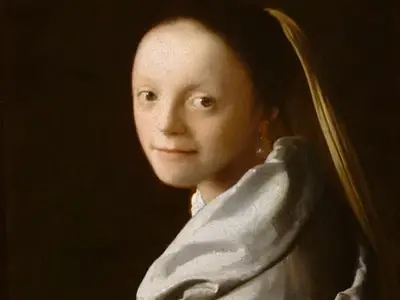Title of Artwork: “Study of a Young Woman”

Artwork by Johannes Vermeer
Year Created 1665-1667
Summary of Study of a Young Woman
Dutch artist Johannes Vermeer painted Portrait of a Young Woman (1666–1677), also known as Study of a Young Woman or Girl with a Veil, which is presently on display at the Metropolitan Museum of Art in New York City.
All About Study of a Young Woman
This painting is frequently mistaken for a variation or pendant painting (counterpart) of the artist’s better-known work, Girl with a Pearl Earring, due to its near-identical size and closeness in tone and arrangement.
Both paintings feature women with pearl earrings, scarves thrown over their shoulders, and a dark backdrop. In addition, a camera obscura was probably used to create both pieces.
The sitter is shown as having a homely face with a small nose and thin lips, as well as a wide-spaced and flat appearance.
Many people assume that this work was painted for a specific client because the model lacks an idealised sense of beauty, yet it’s possible that the model was the artist’s own daughter.
It is possible that the artist used a live model, but as with Girl with a Pearl Earring, he didn’t create the work as a portrait but as a tronie, a Dutch word meaning “visage” or “expression,” a type of Dutch 17th-century picture admired for its “unusual costumes, intriguing physiognomies, hint of personality, and demonstration of artistic skill.”
Like many of Vermeer’s works, this painting makes us wonder about the thoughts and sentiments of the young woman shown.
It’s unusual for Vermeer to have used a dark background to frame his female subjects in Girl with a Pearl Earring and Portrait of a Young Woman.
With this sense of isolation, their fragility and apparent desire to lay their trust in the audience are amplified even more Portrait of a Young Woman by Edward Snow turns “the longing for beauty and perfection into a loving acceptance of what is wrong,” the art historian stated in 1994.
Once owned by Pieter Claesz van Ruijven, the picture may have been owned by his widow Maria de Knuijt until 1681; then by their daughter Magdalena van Ruijven until 1682; and her widower, Jacob Dissius. On May 16, 1696, the Dissius auction house sold a painting by the same name (No. 38, 39 or 40).
When Dr. Luchtmans sold it in Rotterdam for 3 Dutch guilders (approximately 30 grammes of silver) on April 20–22, 1816, it must have seemed like a bargain to him. Brussels’ Prince Auguste Marie Raymond d’Arenberg, by 1829, had acquired the artwork, which he kept at Brussels and Schloss Meppen until the early 1950s.
When the Prince d’Arenberg sold it privately in 1959 (or 1955, according to another source), it was purchased by Mr. Charles Wrightsman and Mrs. Jayne Wrightsman of New York for an estimated $125,000. To honour the memories of curator Theodore Rousseau Jr., the Wrightsmans presented the painting to the Metropolitan Museum of Art in 1979.
Information Citations
En.wikipedia.org, https://en.wikipedia.org/.

























